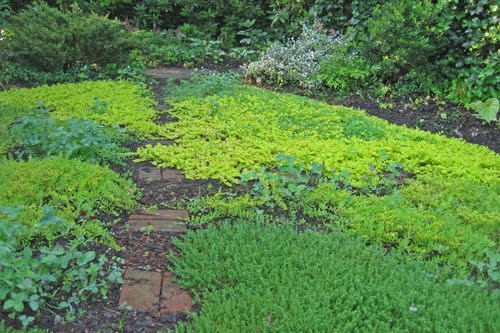
Of course if it’s geometric green perfection you crave in your front yard (as in this Howard Bjornson photo) then lawn alternatives may not be for you. Be heartened though, as scientists are working on less water/less guilt varieties of grass. If you must have your lawn, keep it as high as your mower setting will allow and let the nitrogen-rich clippings fall as they may. Also know that there are many new sprinklers that are more efficient in terms of water usage and application. No more watering the sidewalk!
The idea that the perfect lawn might be a questionable pursuit first came to me upon reading Michael Pollan’s Second Nature: A Gardener’s Education. The grass-rant part (though he is ultimately a graceful, measured writer) is nicely summed up in his shorter article, “Why Mow? The Case Against Lawns.”
Lawn–from launde, (glade), in old French–was originally just a grassy clearing between forest trees that was generally kept low by grazing animals. In Tudor England it became a darling of the wealthy and a status symbol. These lawns of meadow grasses and herbs such as chamomile needed an awful lot of sheep, or laborers with scythes, to deliver the evenly shorn velvety field of green that pleased the gentry. Versailles had its tapis vert, too. So, it evolved.
In 1830 Edwin Budding, a Gloucestershire mill worker, observed a textile-shearing machine and had his Eureka moment: Ooo arr, that be sumut wot thee cud use in t’garden – tis better’n t’awld scythe… The lawn mower was born.
Thank you Edwin for bringing grass to the masses!
If you like plants, then it is really a no-brainer to start encroaching on your turf area with interesting alternatives. If you don’t like ’em, the no-grass benefits of less water, chemicals, time and money spent are the big motivators. And guess what? Many cities will pay you to re-think your grass requirements! Check with your local utility or municipality for grants and rebates.



